Shrinking Nature
The thumbnail sized Nature Conservancy wildlife refuge on Grand Isle is a sad little place, dominated by the roaring engines of dirt bikes and all terrain vehicles on one side and a residential development with houses on stilts and dogs on chains on the other. A steady stream of helicopters roar overhead, whirling to and from the nearby Exxon facility. Only ten percent of the original wooded habitat is left on Grand Isle and this little parcel is the largest remaining stand of live oak-hackberry forest on any barrier island in the Gulf.
During my visit, every once in a while the engines would shut off and I could hear birds singing. At one of these moments, I sat down under some trees. Dappled sunlight filtered through the oak trees and a light breeze rustled their leaves. It was peaceful and lovely. However, in every direction, on the horizon, beyond the little clump of trees, I could see houses, cars, an industrial area, a helicopter overhead.
So I kept my focus close, seeing only what was right in front of me – intentionally not looking beyond. I noticed a lovely, red buckeye sapling, about six feet tall, its stem and flowers red as fresh blood.
Later, standing on a little patch of shell-comprised beach, I found a half oyster shell. The inside was a lustrous, pearly, golden color. Running through its center, completely imbedded into it, was a two inch length of plastic zip-tie. Nature making space for human waste, enveloping it, being enveloped.
I looked out toward the oil facilities and realized the little shell was a microcosm of the Gulf Coast. Nature being squeezed, infiltrated and embedded with the wastes of our oil economy.
Four days into our Gulf Coast mission, the complexity of the situation here has become starkly evident. I’ve met people who had been waiting in line for five hours at the food bank hoping to have their number called before the rations ran out. I’ve hugged a crying mother who was slipping into despair. I’ve listened to the anger and sadness of fishermen who have been successful entrepreneurs their entire lives, now waiting for the monthly BP check of a couple hundred dollars. They rage at the federal government. They rage at BP. But, they support the oil industry. It is simply too imbedded in their economy for them to consider a different way.
One of the most troubling encounters for me was with a woman who oversees the Nature Conservancy program on Grand Isle. Our group met her mid-morning in the bright and airy house that has been set up as the Nature Conservancy offices. She started her presentation by talking of the impacts of the spill – the economic impacts only; she didn’t even mention the harm to the environment.
Then she paused and asked, “How many of you have any direct connection to the oil industry or to oil production?” None of us raised our hands. She went on, “Here in Louisiana you have to understand that the oil industry is very important to our economy. We try really hard to make sure that the oil production is done in a way that is safe for the environment.”
Later, as she was describing the refuge, someone asked if it had been impacted by the oil spill. She quickly said, “Oh no. Because of its location and the booms that BP has set up, it hasn’t been affected at all.”
Still later she revealed that her father, husband, and all three sons had worked, or were working for the oil industry in the region. It’s an economic zip-tie imbedded in the fabric of her life that keeps her linked to the world of oil despite her love for the natural world of her home town.
By Cylvia Hayes, 3EStrategies

























1 COMMENT
Cylvia…very powerful observations- thanks for sharing
Leave a comment